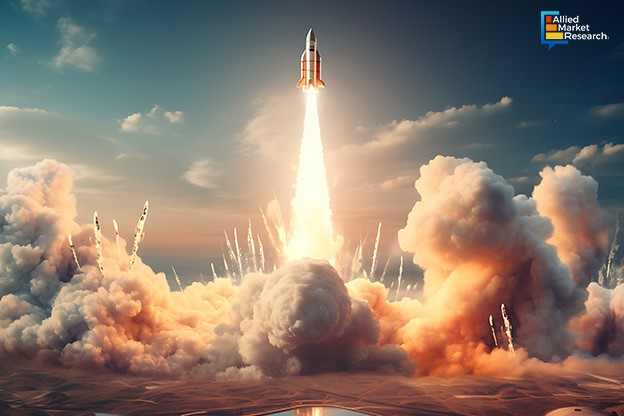Which Advanced Spacecraft Technologies Can Build the Future of Aerospace Businesses?

27 Feb
2024
Highlights:
- Introduction
- Futuristic trends in the spacecraft sector
- Significance of 3D printing
- Integration of AI
- Key discoveries by frontrunners
Used in outer space, the spacecraft technology field has experienced substantial evolution since the initial stages of space exploration. Advanced spacecraft designs that can carry payloads, conduct experiments, and organize long-duration missions replaced conventional rockets based on chemical engines. The spacecraft industry has witnessed transformation due to advanced technologies such as quantum computing, big data, 3D printing, and 5G.
Space infrastructure has a crucial role in many services, such as weather forecasts, remote sensing, global positioning system GPS navigation, satellite, TV, and long-distance communications. These services were developed by new trends in the space industry, such as smart propulsion, space robotics, and space traffic management. These factors are positively influencing the spacecraft industry.
Which prominent trends fuel the growth of the spacecraft sector?
In the past few years, spacecraft designs have experienced several technological advancements. From advanced propulsion to AI, these technologies have transformed the sector landscape.
- Robotic spacecraft: A revolution in unmanned missions
Robotic spacecraft plays a vital role in exploring the solar system and beyond, along with manned missions. Unmanned spacecrafts explore distant planets, moons, and asteroids, providing valuable insight into earth’s cosmic neighbors. Owing to this, the unmanned spacecraft sector is expected to show an absolute revenue growth of $2,655.8 million from 2022 to 2032. These robotic explorers capture stunning images, collect scientific data, and expand the understanding of the universe, setting the stage for future human exploration.
In future, robotics and AI are expected to play a significant role in future spacecraft technology to assist human teams of astronauts. Researchers predict robots to do maintenance and repair work on existing space stations while assisting scientists with data collection and analysis.
- Miniaturization: A step toward space saving
The miniaturization of spacecraft represents a major trend in spacecraft technology. These small, cost-efficient spacecrafts have made it possible for universities, and even large organizations to engage in space exploration and data collection activities. This miniaturization allows effective design, and advancements in industrial technology have led to mass production.
Small satellites perform tasks that are usually difficult for large satellites. These small satellites include proprietary wireless communications networks for scientific observations and data collection. For instance, EnduroSat, a Bulgarian company, provides businesses, exploration companies, and science teams with NanoSats and space services. NanoSat handles robust data of up to 10 payloads. A framework of embedded operational modes is integrated into the spacecraft, improving its performance. Small spacecraft use high-speed X, N, and K band frequencies to provide secure communications for telemetry and telecommand.
Role of 3D printing in simplifying the process of spacecraft development:
Minimizing weight and material requirements is vital in space travel. This is achieved by 3D printing, which enables the on-demand production of tools, spare parts, and even habitats, reducing the need to carry additional inventories. Complex supply chains and expensive transport of goods are often involved in conventional spacecraft manufacturing methods. By using 3D printing, future space missions are expected to rely on locally made materials and save significant costs through logistical requirements elimination.
How does the integration of AI boost the potential of spacecraft?
The advent of AI has significantly revolutionized each sector. AI has improved spacecraft operations and increased its efficiency as well. In space, spacecrafts face an intense environment leading to malfunctions or failures. AI helps to detect possible failure before it occurs, which enables engineers to perform maintenance without delay.
Moreover, the data collected by spacecraft is analyzed by using AI. This has led to improvements in weather forecast accuracy, crop monitoring, and other applications based on satellite data. AI helps to enhance spacecraft communication, which leads to more efficient data transmission and improves the reliability of spacecraft communications systems.
How are the top entities sustaining the competitive industry?
Key players and government entities invest in R&D activities to discover innovative spacecraft technologies. Researchers focus on space-saving ideas, automation, digitalization, and other aspects to launch advanced spacecraft models. For instance, the Japan Aerospace Exploration Agency (JAXA) tested its spacecraft technology designed to examine and eliminate asteroids on December 21, 2023. JAXA emphasizes the need for such technology, as space rocks strike the Earth every 100 to 1,000 years and cause potential damage.
Space debris has become a growing concern in the aerospace industry. Astroscale launched the first debris inspection spacecraft, ADRAS-J, on 19th February 2024 to resolve this issue. The Japanese Agency for Space Research and Aeronautics, JAXA, chose the ADRAS-J spacecraft to conduct phase I of its commercial debris removal demonstration program.
On the other hand, India achieved a historic milestone by becoming the first country to successfully land a spacecraft near the south pole of the moon on 23rd August 2023. The primary purpose of the Vikram Lander is to facilitate the position of the Pragyaan lunar rover and other payloads on the surface of the Moon. The Indian spacecraft sector is anticipated to manifest a noteworthy CAGR of 8.4% by 2032.
To conclude, the spacecraft industry has experienced growth due to a rise in space exploration missions and a surge in investments by private companies & government entities. However, a rise in the adoption of 3D printing for fast manufacturing and growth in spacecraft infrastructure development projects are expected to transform the landscape of the spacecraft sector in the upcoming years.
For a detailed analysis of the global spacecraft industry, contact our experts today

Rosy Behera
Author's Bio- Rosy Behera holds a bachelor’s degree in Electrical and Electronics Engineering and now she is a content writer by profession. She loves to portray her thoughts and ideas with a nice command of words. Grabbing an audience with her creative write-ups is one of her biggest assets so far. Apart from writing, she is a certified “Odisi” dancer and has done Gardharva in Drawing, Painting, and Arts. She always explores new things through travel and is a big foodie.
How Are Advancements in Satellite Antenna Technology Helping Telecommunication Businesses Flourish?
Avenue: Entire Library membership of Allied Market Research Reports at your disposal
- Avenue is an innovative subscription-based online report database.
- Avail an online access to the entire library of syndicated reports on more than 2,000 niche industries and company profiles on more than 12,000 firms across 11 domains.
- A cost-effective model tailored for entrepreneurs, investors, and students & researchers at universities.
- Request customizations, suggest new reports, and avail analyst support as per your requirements.
- Get an access to the library of reports at any time from any device and anywhere.
Related Post
-
How are Submarine Cables Transforming Global Connectivity with Enhanced User Experience?
-
Endoscopy Procedures: Transformations in Techniques and Applications
-
AI-Powered Video Analytics: How the Product Actually Works for enterprises
-
Painting Robots: Transforming Precision Coating and Creative Applications
-
Innovations in Pharmacovigilance Systems Advancing Patient Safety
-
Understanding Edge Security: Keeping Data Safe Near the Source
-
Exploring the Use and Advancements of 3D Laser Scanners in Professional Applications
-
Reinforcing Industrial Controls with Smarter Tools and Training








